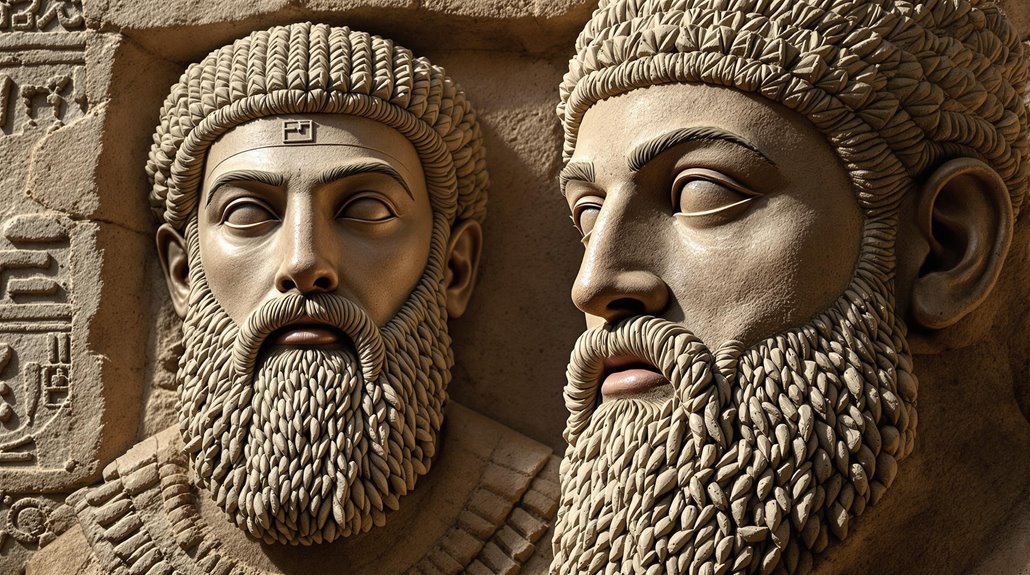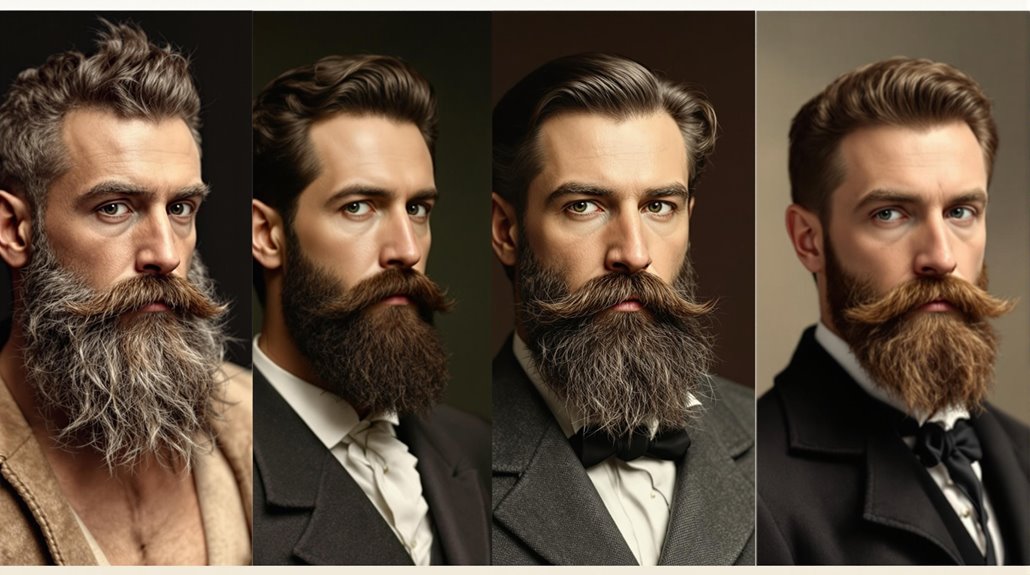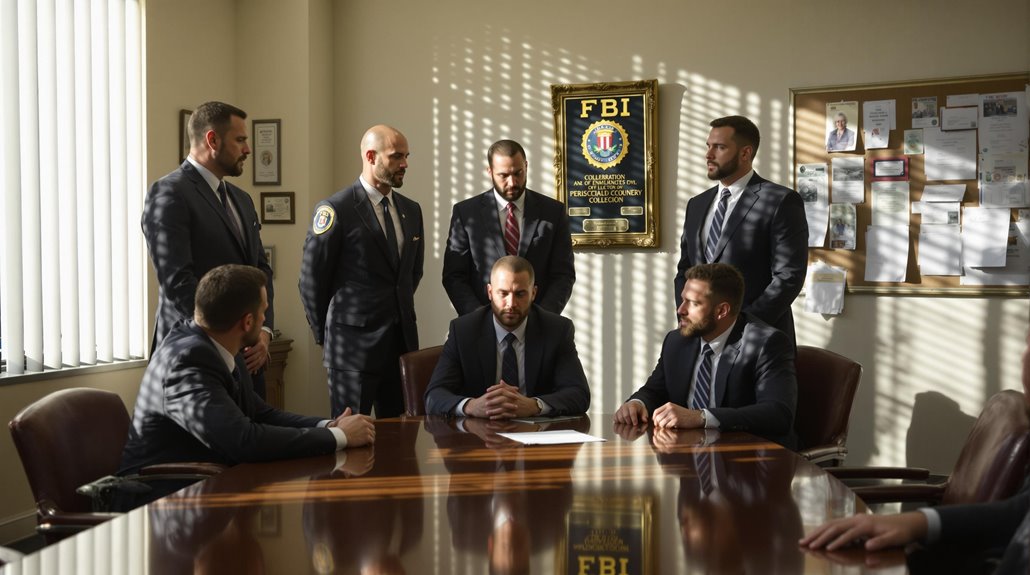What Culture Started Beards?

The genesis of embracing beards traces back to ancient Egypt. Egyptian society not only sported beards but saw them as a symbol of wealth and divinity, often adorning them with opulent accessories like pure gold. The practice evolved elsewhere, like Mesopotamia and Greece, where beards signified strength, wisdom, and social status. The tradition persisted through cultures like the Vikings and underwent changes in modern times. But the Egyptians were the real trend-setters. Speaking of trends, there's more insight awaiting you into how beard styles have been influenced historically and how societal norms continue to shape facial hair fashion today.
Understanding Beard Biology
Diving into the world of beard biology, you'll quickly uncover it's not just about letting your facial hair grow wild. Beard growth is a complex process that typically begins during puberty, around the period of 18, as hormonal changes trigger your body. Remarkably, a derivative of testosterone, dihydrotestosterone (DHT), plays a vital role in stimulating the development of facial hair by acting on your hair follicles.
However, your genetic makeup also considerably determines the rate, density, and pattern of your beard growth, causing variations across different ethnicities. If you've ever wondered why your beard seems to grow faster or slower at different times of the year, it's because your testosterone levels fluctuate seasonally, influencing DHT production and subsequently, your beard growth.
But remember, growing a beard isn't a one-and-done affair. Regular grooming practices, such as washing with soap or shampoo and using conditioners, can greatly improve the health and appearance of your beard. They promote softness and cleanliness, ensuring your facial hair doesn't just grow, but thrives. So, understand your beard biology and give your facial hair the care it deserves.
Historical Significance of Beards
Having examined the biological factors that guide the growth and maintenance of a beard, it's fascinating to look back in time and understand the deeper implications of beards in different societies. Ancient History is strewn with instances where beard styles have represented more than just a physical attribute.
In Egypt, well-groomed beards were a sign of wealth and divinity, often adorned with gold and aromatic oils. Mesopotamians associated long, thick beards with strength and social status, with soldiers sporting them as a badge of honor. Laws governing beard grooming practices mirrored societal norms.
Greek philosophers, on the other hand, saw beards as an emblem of wisdom. Long beards were revered, while military leaders preferred shorter styles, signifying discipline. The Romans had a love-hate relationship with beards, oscillating between clean-shaven trends and the resurgence of facial hair, reflecting changing cultural values.
Viking culture held full, bushy beards in high regard as symbols of bravery and strength. They even influenced modern beard aesthetics with styles incorporating braids and decorative beads. So, next time you see a beard, remember it's not just facial hair; it's a piece of history.
Evolution of Beard Styles

Tracing back to ancient civilizations, you'll find that the evolution of beard styles tells a fascinating story. Beards were more than just facial adornments; they were status symbols and declarations of intent. In Ancient Egypt, beards glittered with gold and glistened with oils, portraying wealth and divine authority.
Mesopotamian culture took this a step further. Here, beards were thick and long, embodying military strength and social standing. Even laws were enacted for their maintenance, indicating their importance in society.
As you explore deeper into history, you'll notice the Greeks altering beard styles. Long beards were associated with philosophers, symbolizing wisdom, while shorter ones were the mark of military leaders.
The Roman Empire saw a fluctuation in beard popularity, shifting from admiration to clean-shaven looks, only to return to beards reflecting changing cultural values.
Finally, let's not forget the Vikings. Their elaborate beard styles, complete with braids and decorative elements, have left a lasting impact on modern beard aesthetics. This evolution of beard styles, weaving through centuries and civilizations, is a reflection of the enduring allure of beards. Watch out for the next subtopic, "Impact of Social Norms."
Impact of Social Norms
While the evolution of beard styles is fascinating, the shifting social norms surrounding these styles are likewise intriguing. You see, the cultural history of beards is rich and varied. In ancient Egypt, for instance, a well-groomed beard was more than just a fashion statement. It was a symbol of divine authority and social status.
Fast forward to the Middle Ages, and the beard had become a mark of honor among knights. In fact, English law would fine anyone who dared to cut off a man's beard! This was a time when social customs equated beards with masculinity and honor.
But with the advent of safety razors in the 19th century, clean-shaven faces became the norm, reflecting a shift in social attitudes towards masculinity. The counterculture movements of the 60s, however, brought facial hair back in style. The Hippie Beard, for instance, emerged as a rebellious response to societal grooming expectations.
Today, you'll find that society accepts diverse beard styles. They're seen as expressions of individuality and personal identity, showcasing a significant shift in social norms surrounding facial hair. Beards have come a long way, haven't they?
Future of Beard Trends

Almost every man, at some point, has pondered the future of beard trends. From the dawn of civilization, beards have acted as a sign of manhood, rebellion, and individuality. And it's only getting more intriguing.
In the future, you'll notice beards becoming more of a personal expression. You'll see diverse styles reflecting individual identities and cultural significance. Your local barbershop might even specialize in beard grooming, a proof of facial hair's cultural relevance.
And let's not forget the mighty influence of social media. With platforms like Instagram and YouTube, you're exposed to a wide array of beard styles and grooming techniques. The younger generation, in particular, is lured into trying new styles, continually shaping the future of beard trends.
The industry isn't ignoring the growing interest in sustainability either. You'll find more organic and eco-friendly beard products, aligning with the push towards natural grooming.
Despite the changing times, the future of beards is exciting. As societal norms evolve, so will the beard, adapting to contemporary fashion trends while maintaining its roots in masculinity and rebellion. It's a captivating expedition, and you're a part of it.
Ancient Civilizations and Beards
Engross yourself in the history books and you'll see that your fascination with beards isn't a novel concept. Ancient civilizations have long appreciated and adorned their chins with lush growth. In Egypt, beards were symbols of wealth and power, often garnished with gold. Mesopotamians saw beards as hallmarks of social standing and military might, their grooming practices reflecting their status.
Yet, it's the ancient Greeks that truly soaked beards in symbolism. They saw beards as symbols of masculinity, associating them with virility and wisdom. Picture Socrates, his long beard a sign of his intellectual prowess. You'd have been hard-pressed to find a clean-shaven philosopher back then.
In Viking culture, a well-groomed beard was a badge of bravery and strength. Many a Viking beard was braided, beaded, and revered. Ancient Indian traditions, too, saw long beards as tokens of dignity and wisdom. To cut a beard was a punishment for moral failure.




